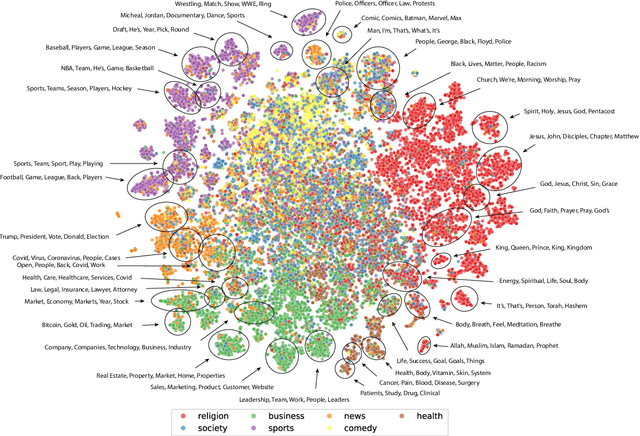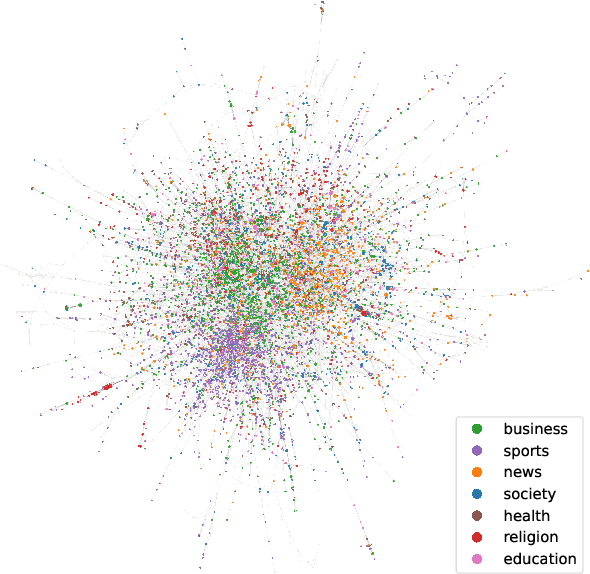David Jurgens
Shammie
Evaluation Framework for AI Systems in "the Wild"
Apr 23, 2025Abstract:Generative AI (GenAI) models have become vital across industries, yet current evaluation methods have not adapted to their widespread use. Traditional evaluations often rely on benchmarks and fixed datasets, frequently failing to reflect real-world performance, which creates a gap between lab-tested outcomes and practical applications. This white paper proposes a comprehensive framework for how we should evaluate real-world GenAI systems, emphasizing diverse, evolving inputs and holistic, dynamic, and ongoing assessment approaches. The paper offers guidance for practitioners on how to design evaluation methods that accurately reflect real-time capabilities, and provides policymakers with recommendations for crafting GenAI policies focused on societal impacts, rather than fixed performance numbers or parameter sizes. We advocate for holistic frameworks that integrate performance, fairness, and ethics and the use of continuous, outcome-oriented methods that combine human and automated assessments while also being transparent to foster trust among stakeholders. Implementing these strategies ensures GenAI models are not only technically proficient but also ethically responsible and impactful.
Beyond Demographics: Fine-tuning Large Language Models to Predict Individuals' Subjective Text Perceptions
Feb 28, 2025Abstract:People naturally vary in their annotations for subjective questions and some of this variation is thought to be due to the person's sociodemographic characteristics. LLMs have also been used to label data, but recent work has shown that models perform poorly when prompted with sociodemographic attributes, suggesting limited inherent sociodemographic knowledge. Here, we ask whether LLMs can be trained to be accurate sociodemographic models of annotator variation. Using a curated dataset of five tasks with standardized sociodemographics, we show that models do improve in sociodemographic prompting when trained but that this performance gain is largely due to models learning annotator-specific behaviour rather than sociodemographic patterns. Across all tasks, our results suggest that models learn little meaningful connection between sociodemographics and annotation, raising doubts about the current use of LLMs for simulating sociodemographic variation and behaviour.
The Noisy Path from Source to Citation: Measuring How Scholars Engage with Past Research
Feb 27, 2025Abstract:Academic citations are widely used for evaluating research and tracing knowledge flows. Such uses typically rely on raw citation counts and neglect variability in citation types. In particular, citations can vary in their fidelity as original knowledge from cited studies may be paraphrased, summarized, or reinterpreted, possibly wrongly, leading to variation in how much information changes from cited to citing paper. In this study, we introduce a computational pipeline to quantify citation fidelity at scale. Using full texts of papers, the pipeline identifies citations in citing papers and the corresponding claims in cited papers, and applies supervised models to measure fidelity at the sentence level. Analyzing a large-scale multi-disciplinary dataset of approximately 13 million citation sentence pairs, we find that citation fidelity is higher when authors cite papers that are 1) more recent and intellectually close, 2) more accessible, and 3) the first author has a lower H-index and the author team is medium-sized. Using a quasi-experiment, we establish the "telephone effect" - when citing papers have low fidelity to the original claim, future papers that cite the citing paper and the original have lower fidelity to the original. Our work reveals systematic differences in citation fidelity, underscoring the limitations of analyses that rely on citation quantity alone and the potential for distortion of evidence.
Neurobiber: Fast and Interpretable Stylistic Feature Extraction
Feb 25, 2025Abstract:Linguistic style is pivotal for understanding how texts convey meaning and fulfill communicative purposes, yet extracting detailed stylistic features at scale remains challenging. We present Neurobiber, a transformer-based system for fast, interpretable style profiling built on Biber's Multidimensional Analysis (MDA). Neurobiber predicts 96 Biber-style features from our open-source BiberPlus library (a Python toolkit that computes stylistic features and provides integrated analytics, e.g., PCA and factor analysis). Despite being up to 56 times faster than existing open source systems, Neurobiber replicates classic MDA insights on the CORE corpus and achieves competitive performance on the PAN 2020 authorship verification task without extensive retraining. Its efficient and interpretable representations readily integrate into downstream NLP pipelines, facilitating large-scale stylometric research, forensic analysis, and real-time text monitoring. All components are made publicly available.
Tokenization is Sensitive to Language Variation
Feb 21, 2025Abstract:Variation in language is ubiquitous and often systematically linked to regional, social, and contextual factors. Tokenizers split texts into smaller units and might behave differently for less common linguistic forms. This might affect downstream LLM performance differently on two types of tasks: Tasks where the model should be robust to language variation (e.g., for semantic tasks like NLI, labels do not depend on whether a text uses British or American spelling) and tasks where the model should be sensitive to language variation (e.g., for form-based tasks like authorship verification, labels depend on whether a text uses British or American spelling). We pre-train BERT base models for the popular Byte-Pair Encoding algorithm to investigate how key algorithmic design choices impact downstream models' performances: fitting corpus, pre-tokenizer and vocabulary size. We find that the best tokenizer varies on the two task types -- with the pre-tokenizer having the biggest impact on performance. Further, we introduce a new approach to estimate tokenizer impact on downstream LLM performance, showing significant improvement over techniques like R\'enyi efficiency. We encourage more work on language variation and its relation to tokenizers and thus LLM performance.
Unstructured Evidence Attribution for Long Context Query Focused Summarization
Feb 20, 2025Abstract:Large language models (LLMs) are capable of generating coherent summaries from very long contexts given a user query. Extracting and properly citing evidence spans could help improve the transparency and reliability of these summaries. At the same time, LLMs suffer from positional biases in terms of which information they understand and attend to, which could affect evidence citation. Whereas previous work has focused on evidence citation with predefined levels of granularity (e.g. sentence, paragraph, document, etc.), we propose the task of long-context query focused summarization with unstructured evidence citation. We show how existing systems struggle to generate and properly cite unstructured evidence from their context, and that evidence tends to be "lost-in-the-middle". To help mitigate this, we create the Summaries with Unstructured Evidence Text dataset (SUnsET), a synthetic dataset generated using a novel domain-agnostic pipeline which can be used as supervision to adapt LLMs to this task. We demonstrate across 5 LLMs of different sizes and 4 datasets with varying document types and lengths that LLMs adapted with SUnsET data generate more relevant and factually consistent evidence than their base models, extract evidence from more diverse locations in their context, and can generate more relevant and consistent summaries.
Are Rules Meant to be Broken? Understanding Multilingual Moral Reasoning as a Computational Pipeline with UniMoral
Feb 19, 2025Abstract:Moral reasoning is a complex cognitive process shaped by individual experiences and cultural contexts and presents unique challenges for computational analysis. While natural language processing (NLP) offers promising tools for studying this phenomenon, current research lacks cohesion, employing discordant datasets and tasks that examine isolated aspects of moral reasoning. We bridge this gap with UniMoral, a unified dataset integrating psychologically grounded and social-media-derived moral dilemmas annotated with labels for action choices, ethical principles, contributing factors, and consequences, alongside annotators' moral and cultural profiles. Recognizing the cultural relativity of moral reasoning, UniMoral spans six languages, Arabic, Chinese, English, Hindi, Russian, and Spanish, capturing diverse socio-cultural contexts. We demonstrate UniMoral's utility through a benchmark evaluations of three large language models (LLMs) across four tasks: action prediction, moral typology classification, factor attribution analysis, and consequence generation. Key findings reveal that while implicitly embedded moral contexts enhance the moral reasoning capability of LLMs, there remains a critical need for increasingly specialized approaches to further advance moral reasoning in these models.
The Muddy Waters of Modeling Empathy in Language: The Practical Impacts of Theoretical Constructs
Jan 24, 2025Abstract:Conceptual operationalizations of empathy in NLP are varied, with some having specific behaviors and properties, while others are more abstract. How these variations relate to one another and capture properties of empathy observable in text remains unclear. To provide insight into this, we analyze the transfer performance of empathy models adapted to empathy tasks with different theoretical groundings. We study (1) the dimensionality of empathy definitions, (2) the correspondence between the defined dimensions and measured/observed properties, and (3) the conduciveness of the data to represent them, finding they have a significant impact to performance compared to other transfer setting features. Characterizing the theoretical grounding of empathy tasks as direct, abstract, or adjacent further indicates that tasks that directly predict specified empathy components have higher transferability. Our work provides empirical evidence for the need for precise and multidimensional empathy operationalizations.
Mapping the Podcast Ecosystem with the Structured Podcast Research Corpus
Nov 12, 2024



Abstract:Podcasts provide highly diverse content to a massive listener base through a unique on-demand modality. However, limited data has prevented large-scale computational analysis of the podcast ecosystem. To fill this gap, we introduce a massive dataset of over 1.1M podcast transcripts that is largely comprehensive of all English language podcasts available through public RSS feeds from May and June of 2020. This data is not limited to text, but rather includes audio features and speaker turns for a subset of 370K episodes, and speaker role inferences and other metadata for all 1.1M episodes. Using this data, we also conduct a foundational investigation into the content, structure, and responsiveness of this ecosystem. Together, our data and analyses open the door to continued computational research of this popular and impactful medium.
A Test of Time: Predicting the Sustainable Success of Online Collaboration in Wikipedia
Oct 24, 2024Abstract:The Internet has significantly expanded the potential for global collaboration, allowing millions of users to contribute to collective projects like Wikipedia. While prior work has assessed the success of online collaborations, most approaches are time-agnostic, evaluating success without considering its longevity. Research on the factors that ensure the long-term preservation of high-quality standards in online collaboration is scarce. In this study, we address this gap. We propose a novel metric, `Sustainable Success,' which measures the ability of collaborative efforts to maintain their quality over time. Using Wikipedia as a case study, we introduce the SustainPedia dataset, which compiles data from over 40K Wikipedia articles, including each article's sustainable success label and more than 300 explanatory features such as edit history, user experience, and team composition. Using this dataset, we develop machine learning models to predict the sustainable success of Wikipedia articles. Our best-performing model achieves a high AU-ROC score of 0.88 on average. Our analysis reveals important insights. For example, we find that the longer an article takes to be recognized as high-quality, the more likely it is to maintain that status over time (i.e., be sustainable). Additionally, user experience emerged as the most critical predictor of sustainability. Our analysis provides insights into broader collective actions beyond Wikipedia (e.g., online activism, crowdsourced open-source software), where the same social dynamics that drive success on Wikipedia might play a role. We make all data and code used for this study publicly available for further research.
 Add to Chrome
Add to Chrome Add to Firefox
Add to Firefox Add to Edge
Add to Edge